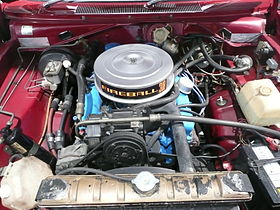Chrysler LA engine
| Chrysler LA engine | |
|---|---|
 |
|
| Overview | |
| Manufacturer | Chrysler |
| Also called | Magnum engine |
| Production | 1964-2003 |
| Combustion chamber | |
| Configuration | |
| Cylinder block alloy | Cast iron |
| Cylinder head alloy | Cast iron |
| Valvetrain | OHV |
| Combustion | |
| Fuel system | |
| Fuel type | Gasoline |
| Oil system | Wet sump |
| Cooling system | Water-cooled |
| Chronology | |
| Predecessor | Chrysler A engine |
| Successor | |
The LA engines are a family of pushrod OHV 90° V-configured gasoline engines built by Chrysler Corporation. It was factory-installed in passenger vehicles, trucks and vans, commercial vehicles, marine and industrial applications from 1964 through 2003. The combustion chambers are wedge-shaped, rather than the polyspherical combustion chambers in the predecessor A engine or the hemispherical chambers in the Chrysler Hemi engine. All versions are made of cast iron, except for the Viper V10 which is aluminum. LA engines have the same 4.46-inch (113 mm) bore spacing as the A engines.
LA engines were made at Chrysler's Mound Road Engine plant in Detroit, Michigan, as well as plants in Canada and Mexico. The "LA" stands for "Light A", as the older "A" engine it was closely based on was nearly 50 pounds heavier.Willem Weertman, who later became Chief Engineer – Engine Design and Development, was in charge of the conversion. The basic design of the LA engine would go unchanged through the development of the "Magnum" upgrade (1992-'93) and into the 21st Century, although the finer details were changed to create a more powerful, efficient, and modern powerplant.
The 273 (4.5 L) was the first LA engine, beginning model year 1964 and offered through 1969, rated at 180 BHP. It had a 3.625 in (92 mm) bore and 3.31 in (84 mm) stroke. It had a mechanical solid lifter valvetrain until 1968 when hydraulic lifters were introduced; hydraulic lifters generally make for a quieter valvetrain. The reciprocating assembly included a cast or forged steel crankshaft, drop forged steel connecting rods and cast aluminum pistons. The valvetrain consisted of a cast nodular iron camshaft, solid or hydraulic lifters, solid pushrods and shaft-mounted, malleable iron rocker arms (stamped steel on later hydraulic-cam engines). These actuated the overhead steel intake and exhaust valves. The cylinder heads featured wedge-shaped combustion chambers with a single intake and a single exhaust valve for each cylinder. Spark plugs were located in the side of the cylinder head, between the exhaust ports.
...
Wikipedia
